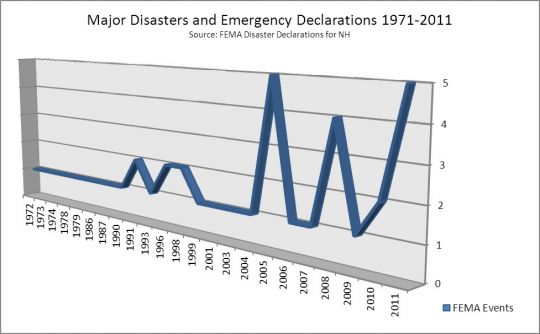



It's a Safe Haven to Live In.
-Dublin
We have to stop thinking in terms of ‘100-year events.’ It’s not going to be another 100 years before we see another extreme storm such as Sandy.
– Art Lerner-Lam, deputy director, Lamont-Doherty Earth Observatory
Hurricane Sandy marks the 11th major disaster declaration for New Hampshire in the past 5 years. That is an average of 2.2 major disasters per year. Since 2007 we have seen a tornado, an epic ice storm, a windstorm, a nor’easter in October, several major flooding events and also the fourth warmest winter on record.
The following graph shows the frequency of major disasters and emergency declarations in New Hampshire over the past 40 years. As you can see there has been a noticeable increase in the number of disasters and emergencies that we are facing in the past 10 years. Since 1999, FEMA public assistance grants alone to New Hampshire total over $90 million. The safety, health and economic impact of these events is a major concern to our communities.

There has been a dramatic change in our weather patterns and it’s important for us to implement not only mitigation efforts, but to start thinking about adaptation and resilience as well.
One topic under A Granite State Future will be Comprehensive Climate Change Impacts Assessments that evaluate a range of likely climate change impacts and are used as a basis for defining adaptation actions and strategies.
The University of New Hampshire’s Carbon Solutions New England will prepare Comprehensive Climate Change Impact Assessments for each of the regional planning commissions. They will begin with the Northeast Climate Impacts Assessment (NECIA) that provides a detailed analysis of the impacts of future climate change and variability over the 21st century. UNH will combine the results from NECIA, with NH-specific climate impact assessments that are currently underway. These, in turn, will serve as the basis for completing regional climate impact assessments.
Hazard Mitigation Plans for New Hampshire municipalities are updated every 5 years. These plans include mitigation strategies to address the effects of natural disasters before they happen. The Climate Change Impact Assessments will be a resource to New Hampshire municipalities for their Hazard Mitigation Plans. Mitigation and adaptation strategies developed for our communities and our state will help to lessen the safety, health and economic impacts of emergencies and disasters. A comprehensive, regional view of climate change impacts will help all of our communities to plan for the future and to be prepared for the next extreme weather event.
By failing to prepare, you are preparing to fail.
- Benjamin Franklin
